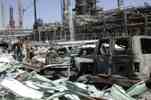
Steelworkers, API Part Ways on Refinery Fatigue Standard
The union and the oil and gas industry's trade association issued press releases Aug. 4 accusing each other of undermining their work on a national standard requested by the U.S. Chemical Safety Board after the BP refinery explosion in Texas City in 2005.
Two key parties working toward a national standard addressing working hours for refinery employees went their separate ways this week, with the United Steelworkers withdrawing Tuesday from talks with the American Petroleum Institute and the oil industry. The U.S. Chemical Safety Board recommended that they work together on a standard, using a process recognized by ANSI, to address fatigue in the industry. The recommendation was made in CSB's report on the BP refinery explosion in Texas City, Texas, in 2005.
CSB's recommendation asked the two to cooperatively develop both a standard containing process safety performance indicators for petrochemical operations and refineries and also a standard containing fatigue prevention guidelines for those "that, at a minimum, limit[s] hours and days of work and address[es] shift work."
The union said API excluded environmental and public interest organizations from the committees developing the standards and gave each of the 22 oil companies one vote, giving them the upper hand when each of the three oil worker union representatives also had one vote. "After months of very little progress, we found the API and the industry did not understand the meaning of consensus," said USW International Vice President Gary Beevers, who is in charge of the union’s National Oil Bargaining program. "This industry will simply not get serious about developing standards that have real meat in them and reflect a true consensus," he added. "The Bureau of Labor Statistics data is misleading because it doesn't account for the injuries, illnesses, and deaths of contractors on the job -— only refinery employees. A low injury rate is not indicative of a safe workplace. Take BP's Texas City refinery, for example: It had a low injury rate at the time of the 2005 explosion and fire. Yet investigations afterwards revealed that their safety was lacking, the PSM [Process Safety Management] standard wasn't followed, and the company didn't regard or learn from its previous safety investigations.
"If refiners were actually adhering to the PSM standard, we wouldn't see leaks, equipment failures, releases, fires, explosions, and other process upsets on a regular basis," he said. "The last survey of our members and OSHA's National Emphasis Program on refineries confirm this. OSHA said its inspectors repeatedly saw similar problems at the refineries it inspected and recently sent letters to managers at more than 100 refineries urging them to comply with the PSM standard."
API responded by saying the union's interest was furthering its bargaining position, not protecting workers. "We regret that the United Steelworkers have decided to withdraw from the multi-stakeholder consensus building process, currently in its final stages, to develop two important industry safety standards to address worker fatigue management and process safety performance indicators. The protection of our workers, our contractors, and our neighbors is the top priority for the oil and natural gas industry. API and its member companies believe it is important for the industry, the government, and other stakeholders to work together to improve worker safety, including the completion of these two important safety standards pursuant to the recommendations from the U.S. Chemical Safety Board," API's release states.
"The standards development process is being conducted in accordance with procedures approved by the American National Standards Institute, as directed by the CSB. This effort brought together multi-stakeholder committees comprised of representatives from industry, labor, government, academia, consultants, engineering and construction, and other trade associations. The USW was included at the inception of the outreach effort and was asked repeatedly to provide additional representatives to the committees. ANSI has regularly reviewed the standards development process and there have been no indications of any deficiencies in the way the effort is being managed. Likewise, the CSB has been briefed regularly on the progress of this work.
"Unfortunately, the USW is attempting to undermine a process aimed at improving worker safety. USW is trying to silence the voices of other stakeholders on the committee by making specific demands directly tied to their National Oil Bargaining Strategy. One example is a USW demand to write into the standard a specific numerical target for reductions in open shifts. While the members on the multi-stakeholder committee broadly support the concept of setting such targets, there is no support for putting a specific number into the standard because a 'one size fits all' approach will not work across the industry. The consensus of the committee is that open shift targets should be set at the site level and then progress made towards the targets is to be reviewed annually with key stakeholders, including representatives of the workforce.
In the statement, API said the committees will continue work on both standards, with the expectation they will be issued in 2009. "Process safety management is essential to the protection of employees, contractors and the communities in which API members operate," API stated. "The industry invests significant resources to identify and correct hazards and to train our workforce on safe equipment operation, as well as proper inspection and maintenance procedures. API has developed and maintains more than 100 safe operating standards and safe work practices, many of which are cited in OSHA regulations."